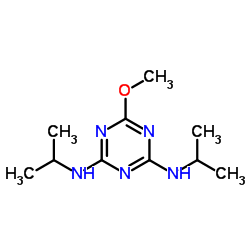Evaluation of the methoxytriazine herbicide prometon using a short-term fathead minnow reproduction test and a suite of in vitro bioassays.
Daniel L Villeneuve, Margaret B Murphy, Michael D Kahl, Kathleen M Jensen, Brian C Butterworth, Elizabeth A Makynen, Elizabeth J Durhan, Ann Linnum, Richard L Leino, Lawrence R Curtis, John P Giesy, Gerald T Ankley
Index: Environ. Toxicol. Chem. 25(8) , 2143-53, (2006)
Full Text: HTML
Abstract
Prometon is one of the most consistently detected herbicides in the U.S. environment. However, no previous assessment of the potential for prometon or related methoxytriazine herbicides to act as endocrine-disrupting chemicals has been conducted. This study used an array of in vitro bioassays to assess whether prometon, atraton, terbumeton, or secbumeton might act as potent (ant)agonists of the aryl hydrocarbon, estrogen, androgen, or glucocorticoid receptors or as aromatase inhibitors or inducers in vitro. Potential effects of prometon were also evaluated using a 21-d fathead minnow reproduction assay. Concentrations of methoxytriazines, as great as 1 mg/L (4.4 microM), did not induce significant dioxin-like responses in H4IIE-luc cells, estrogenic responses in MVLN cells, or androgen or glucocorticoid receptor-mediated responses in MDA-kb2 cells, nor did the methoxytriazines significantly affect aromatase activity in vitro. In the fathead minnow assay, exposure to 20, 200, or 1,000 microg prometon/L significantly reduced the weight of the male fat pad (an androgen-responsive tissue) relative to body weight. Exposure to 20 microg prometon/L significantly increased female plasma testosterone concentrations, but the effect was not observed at greater concentrations. Overall, prometon did not significantly reduce fecundity over the 21-d exposure, nor were other endpoints, including plasma vitellogenin and estradiol concentrations, brain and ovary aromatase activity, and male tubercle index, significantly affected. Evidence from our work suggests that prometon may cause subtle endocrine and/or reproductive effects in fathead minnows, but no clear mechanism of action was observed. The relevance of these effects to hazard assessment for the pesticide is uncertain.
Related Compounds
| Structure | Name/CAS No. | Molecular Formula | Articles |
|---|---|---|---|
 |
Prometon
CAS:1610-18-0 |
C10H19N5O |
|
Identification of prometon, deisopropylprometon, and hydroxy...
2014-11-01 [Sci. Total Environ. 497-498 , 459-66, (2014)] |
|
Mutagenicity testing of nine herbicides and pesticides curre...
1995-01-01 [Environ. Mol. Mutagen. 25(2) , 148-53, (1995)] |
|
[Degradation of Prometon by O3/H2O2].
2012-04-01 [Huan Jing Ke Xue 33(4) , 1260-6, (2012)] |
|
Comparison between the short-term and the long-term toxicity...
2009-01-01 [Water Res. 43(6) , 1731-9, (2009)] |
|
Combined photobacterium toxicity of herbicide mixtures conta...
2009-04-01 [Chemosphere 75(3) , 381-8, (2009)] |